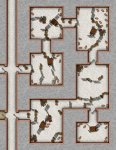The Green Hermit
Hero
Hiya!
I agree with @3catcircus about the "clean black and white"...although a "clean coloured version" can be almost as easy to read....but those are almost non-existent, as most/many people think that making everything "blurry and blended, with lots of dots around the edges" is a good thing.
Harn has some amazingly clean maps; both their indoor b/w ones, and their outdoor colour ones. Simple colour scheme, mostly 'flat' colours, no shading, and simple symbolism (re: squiggly lines for farm/garden furrows, for example). I'm also partial to the maps from Warhammer (1st edition) in the main rule book. Black and white, with more of a 'hand drawn' vibe to them than the Harn ones (Powers & Perils also has this sort of map style).
Another issue with color is color blindness. Not just the common red/green. My son has blue/yellow color blindness and can't see blue on white. At all.




